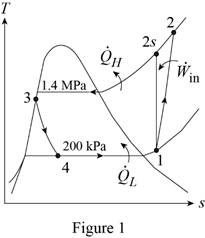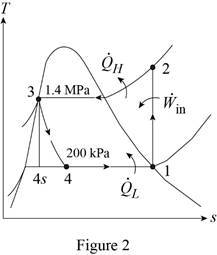
A refrigerator uses refrigerant-134a as the working fluid and operates on the vapor-compression refrigeration cycle. The evaporator and condenser pressures are 200 kPa and 1400 kPa, respectively. The isentropic efficiency of the compressor is 88 percent. The refrigerant enters the compressor at a rate of 0.025 kg/s superheated by 10.1°C and leaves the condenser subcooled by 4.4°C. Determine (a) the rate of cooling provided by the evaporator, the power input, and the COP. Determine (b) the same parameters if the cycle operated on the ideal vapor-compression refrigeration cycle between the same pressure limits.
(a)
The rate of cooling provided by the evaporator, the power input and the COP.
Answer to Problem 21P
The rate of cooling provided by the evaporator is
Explanation of Solution
Show the T-s diagram for the vapor-compression refrigeration cycle as in Figure (1).

Express specific enthalpy at state 2 by using the formula of Carnot efficiency.
Here, Carnot efficiency is
Express rate of heat lost by the evaporator.
Here, mass flow rate of refrigerant is
Express rate of heat supplied to the evaporator.
Here, specific enthalpy at state 3 is
Express power input.
Express coefficient of performance.
Express initial temperature.
Here, saturated temperature at initial pressure of
Express temperature at state 3.
Here, saturated temperature at pressure at state 3 of
Conclusion:
Refer Table A-12, “saturated refrigerant 134a-pressure table”, and write the saturated temperature at initial pressure of
Substitute
Refer Table A-12, “saturated refrigerant 134a-pressure table”, and write the saturated temperature at pressure at state 3 of
Substitute
Refer Table A-13, “superheated refrigerant-134a”, and write the properties corresponding to initial pressure
Here, initial specific entropy is
From Figure (1), the initial specific entropy is equal to specific entropy at state 2.
Perform unit conversion of pressure at state 2 from
Refer Table A-13, “superheated refrigerant 134a”, and write the specific enthalpy at state 2s corresponding to pressure at state 2 of
Write the formula of interpolation method of two variables.
Here, the variables denote by x and y is specific entropy at state 2 and specific enthalpy at state 2 respectively.
Show the specific enthalpy at state 2s corresponding to specific entropy as in Table (1).
|
Specific entropy at state 2 |
Specific enthalpy at state 2s |
| 0.9389 | 285.47 |
| 0.9699 | |
| 0.9733 | 297.10 |
Substitute
From Figure (1), write the specific enthalpy at state 3 is equal to state 4 due to throttling process.
Here, specific enthalpy at state 3 is
Refer Table A-11, “saturated refrigerant-134a-pressure table”, and write the specific enthalpy at state 3 corresponding to temperature at state 3 of
Substitute
Substitute
Substitute
Hence, the rate of cooling provided by the evaporator is
Substitute
Hence, the power input is
Substitute
Hence, the COP is
(b)
The rate of cooling provided by the evaporator, the power input and the COP.
Answer to Problem 21P
The rate of cooling provided by the evaporator is
Explanation of Solution
Show the T-s diagram for the ideal vapor-compression refrigeration cycle as in Figure (2).

Express rate of heat lost by the evaporator.
Here, mass flow rate of refrigerant is
Express rate of heat supplied to the evaporator.
Here, specific enthalpy at state 3 is
Express power input.
Express coefficient of performance.
Conclusion:
From Figure (2), write the specific enthalpy at state 3 is equal to state 4 due to throttling process.
Here, specific enthalpy at state 3 is
Refer Table A-12, “saturated refrigerant-134a-pressure table”, and write the properties corresponding to pressure at state 1
Here, specific entropy at state 1 is
Refer Table A-13, “superheated refrigerant 134a”, and write the specific enthalpy at state 2 corresponding to pressure at state 2 of
Show the specific enthalpy at state 2 corresponding to specific entropy as in Table (2).
|
Specific entropy at state 2 |
Specific enthalpy at state 2 |
| 0.9107 | 276.17 |
| 0.9378 | |
| 0.9389 | 285.47 |
Substitute
Refer Table A-12, “saturated refrigerant-134a-pressure table”, and write the specific enthalpy at state 3 corresponding to pressure at state 3
Here, specific enthalpy at saturated liquid is
Substitute
Substitute
Hence, the rate of cooling provided by the evaporator is
Substitute
Hence, the power input is
Substitute
Hence, the COP is
Want to see more full solutions like this?
Chapter 11 Solutions
Thermodynamics: An Engineering Approach
- 2. A steam power plant operates on the Rankine cycle in which the steam enters the turbine at 16 MPa and 600°C and the condensate leaves the condenser at 10 kPa. If the isentropic efficiency of the turbine is 87 percent and the isentropic efficiency of the pump is 85 percent, determine (a) the thermal efficiency of the cycle and (b) the net power output of the plant for a mass flow rate of 15 kg/s.arrow_forwardConsider a refrigerator that operates on the vapor compression refrigeration cycle with R-134a as the working fluid. The refrigerant enters the compressor as a saturated vapor at 140 kPa, and exits at 800 kPa and 60 degrees Celsius, and leaves the condenser as a saturated liquid at 800 kPa. The COP of this refrigerator is:arrow_forwardConsider a refrigeration system that operates on an actual vapor-compression refrigeration cycle with refrigerant 134a as the working fluid with an isentropic efficiency of a compressor of 75.1%. The refrigerant enters the compressor as saturated vapor at 140 kPa and is compressed to 800 kPa. Determine the value of h2 in kj/hg, answer in 4 decimal places with unit analysis. Subject: Thermodynamics 2arrow_forward
- A refrigerated room is kept at −18◦C by a vapor-compression cycle with R-134a as the refrigerant. Heat is rejected to cooling water that enters the condenser at 14◦C at a rate of 0.35 kg/s and leaves at 22◦C. The refrigerant enters the condenser at 1.2MPa and 50◦C and leaves at the same pressure subcooled by 5◦C. If the compressor consumes 5.5 kW of power, determine (a) the mass flow rate of the refrigerant, (b) the refrigeration load and the COP, (c) the second-law efficiency of the refrigerator and the total exergy destruction in the cycle, and (d) the exergy destruction in the condenser. Take specific heat of water to be 4.18 kJ/kg·◦C.arrow_forwardThe COP of vapor-compression refrigeration cycles improves when the refrigerant is subcooled before it enters the throttling valve. Can the refrigerant be subcooled indefinitely to maximize this effect, or is there a lower limit? Explain.arrow_forwardA standard vapor compression system produces 70.4 kW of refrigeration using R-12as a refrigerant while operating between a condenser temperature of 42 °C and anevaporator temperature of –25 °C.2.1 Draw the p-h diagram of the cycle. 2.2 Determine:(a) the refrigerating effect in kJ/kg, (b) the circulating rate in kg/s, (c) the power supplied, (d) the COP, (e) the heat rejected in kW, and(f) the volume flow rate in m3/s.arrow_forward
- Consider a 300 kJ/min refrigeration system that operates on an ideal vapor-compression refrigeration cycle with refrigerant-134a as the working fluid. The refrigerant enters the compressor as saturated vapor at 140 kPa and is compressed to 800 kPa. Show the cycle on a T-s diagram with respect to saturation lines, and determine (a) the quality of the refrigerant at the end of the throttling process, (b) the coefficient of performance, and (c) the power input to the compressor.arrow_forwardConsider a heat pump that operates on the vapor compression refrigeration cycle with R-134a as the working fluid. The refrigerant enters the compressor as saturated vapor at 180 kPa, and exits at 900 kPa and 40°C, and leaves the condenser as saturated liquid at 900 kPa. The coefficient of performance of this heat pump is a. 5.51 b. 4.58 c. 3.61 d. 4.06 e. 2.87arrow_forwardConsider a heat pump that operates on the vapor compression refrigeration cycle with R-134a as the working fluid. The refrigerant enters the compressor as saturated vapor at 100 kPa, and exits at 900 kPa and 70°C, and leaves the condenser as saturated liquid at 900 kPa. The coefficient of performance of this heat pump isarrow_forward
- Determine the power required to operate a refrigerator using the ideal vapor-compression cycle with R-134a to remove 8 kW of heat and within the pressure limits of 320 and 700 kPa.arrow_forwardA refrigerator uses R-134a as the working fluid and operates on an ideal vapor compression cycle between 0.14 MPa and 0.8 MPa. If the mass flow rate of the refrigerant is 0.06 kg/s, determine (a) the rate of heat removal from the refrigerated space, (b) the power input to the compressor, (c) the heat rejection rate in the condenser, and (d) the COP.arrow_forwardA commercial refrigerator with refrigerant-134a as the working fluid is used to keep the refrigerated space at –35°C by rejecting waste heat to cooling water that enters the condenser at 18°C at a rate of 0.25 kg/s and leaves at 26°C. The refrigerant enters the condenser at 1.2 MPa and 50°C and leaves at the same pressure subcooled by 5°C. If the compressor consumes 3.3 kW of power, determine the mass flow rate of the refrigerant,arrow_forward
 Refrigeration and Air Conditioning Technology (Mi...Mechanical EngineeringISBN:9781305578296Author:John Tomczyk, Eugene Silberstein, Bill Whitman, Bill JohnsonPublisher:Cengage Learning
Refrigeration and Air Conditioning Technology (Mi...Mechanical EngineeringISBN:9781305578296Author:John Tomczyk, Eugene Silberstein, Bill Whitman, Bill JohnsonPublisher:Cengage Learning
